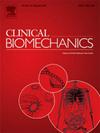Analysis wave speed of optic nerve and optic nerve head for assessing normal tension glaucoma by using vibro-elastography technique
IF 1.4
3区 医学
Q4 ENGINEERING, BIOMEDICAL
引用次数: 0
Abstract
Background
This research aims to evaluate wave speed and viscoelasticity of ocular tissues including the optic nerve and optic nerve head of human eyes between normal tension glaucoma patients and healthy controls by using vibro-elastography techniques.
Methods
Participants included 12 patients and 12 controls. Wave speed was measured at the optic nerve and optic nerve head in each subject and viscoelasticity was estimated by using Voigt model. Wave speed and viscoelasticity of the optic nerve and optic nerve head were compared between patients and controls by linear mixed models via a restricted maximum likelihood method. The correlation between intraocular pressure and wave speed, elasticity, and viscosity of patients was performed using the Pearson correlation coefficient.
Findings
Significant differences in wave speed (p < 0.0005), elasticity (p = 0.0001) and viscosity p < 0.0001) between patients and controls at the optic nerve head. There was a moderate negative correlation (r = −0.50, p < 0.05) between wave speed and elasticity and intraocular pressure at the optic nerve of patients but no correlation (p > 0.05) between wave speed, elasticity, and viscosity and intraocular pressure at the optic nerve head of patients. No significant difference and correlation among wave speed, elasticity, and viscosity vs. intraocular pressure of the control group at the optic nerve and optic nerve head.
Interpretation
Ultrasound vibro-elastography is useful for noninvasive measurement of viscoelasticity of ocular structures. The glaucoma patient is associated with biomechanical property changes in the optic nerve and optic nerve head, suggesting another way to assess glaucoma focusing on the optic nerve and optic nerve head.
用振动弹性成像技术分析视神经和视神经头的波速对正常张力性青光眼的评价
背景本研究旨在利用振动弹性成像技术评估正常张力青光眼患者和健康对照组眼部组织(包括视神经和视神经头)的波速和粘弹性。测量每个受试者视神经和视神经头的波速,并使用 Voigt 模型估算粘弹性。通过受限最大似然法的线性混合模型,比较了患者和对照组视神经和视神经头的波速和粘弹性。结果患者和对照组在视神经头的波速(p < 0.0005)、弹性(p = 0.0001)和粘度(p < 0.0001)方面存在显著差异。患者视神经处的波速和弹性与眼内压呈中度负相关(r = -0.50,p < 0.05),但患者视神经头处的波速、弹性和粘度与眼内压无相关性(p > 0.05)。对照组视神经和视神经头的波速、弹性和粘度与眼压无明显差异和相关性。青光眼患者的视神经和视神经头的生物力学特性发生了变化,这表明评估青光眼的另一种方法侧重于视神经和视神经头。
本文章由计算机程序翻译,如有差异,请以英文原文为准。
求助全文
约1分钟内获得全文
求助全文
来源期刊

Clinical Biomechanics
医学-工程:生物医学
CiteScore
3.30
自引率
5.60%
发文量
189
审稿时长
12.3 weeks
期刊介绍:
Clinical Biomechanics is an international multidisciplinary journal of biomechanics with a focus on medical and clinical applications of new knowledge in the field.
The science of biomechanics helps explain the causes of cell, tissue, organ and body system disorders, and supports clinicians in the diagnosis, prognosis and evaluation of treatment methods and technologies. Clinical Biomechanics aims to strengthen the links between laboratory and clinic by publishing cutting-edge biomechanics research which helps to explain the causes of injury and disease, and which provides evidence contributing to improved clinical management.
A rigorous peer review system is employed and every attempt is made to process and publish top-quality papers promptly.
Clinical Biomechanics explores all facets of body system, organ, tissue and cell biomechanics, with an emphasis on medical and clinical applications of the basic science aspects. The role of basic science is therefore recognized in a medical or clinical context. The readership of the journal closely reflects its multi-disciplinary contents, being a balance of scientists, engineers and clinicians.
The contents are in the form of research papers, brief reports, review papers and correspondence, whilst special interest issues and supplements are published from time to time.
Disciplines covered include biomechanics and mechanobiology at all scales, bioengineering and use of tissue engineering and biomaterials for clinical applications, biophysics, as well as biomechanical aspects of medical robotics, ergonomics, physical and occupational therapeutics and rehabilitation.
 求助内容:
求助内容: 应助结果提醒方式:
应助结果提醒方式:


